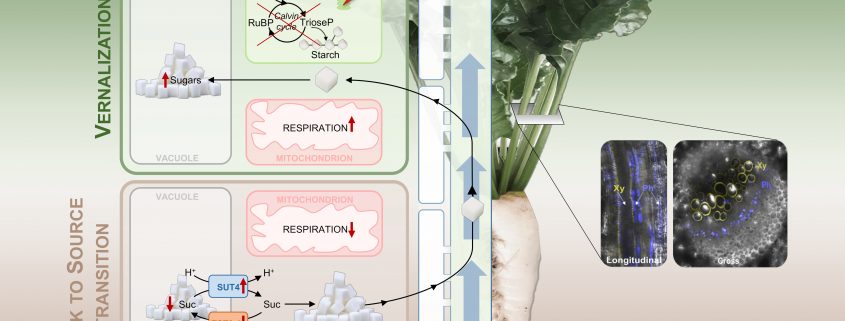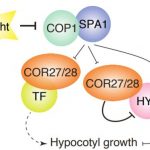Chilling Lessons from Sugar Beets: Switching Sources
Rodrigues et al. found that the source and sink identities of sugar beet shoots vs. taproots are switched upon vernalization (chilling) due to a cold-induced reversal of the phloem stream. Plant Cell https://doi.org/10.1105/tpc.20.00072
By Cristina Martins Rodriguesa, Christina Müdsamb and Benjamin Pommerreniga
a Plant Physiology, University of Kaiserslautern, Kaiserslautern, Germany
b Biochemistry, Friedrich-Alexander-Universität (FAU) Erlangen-Nürnberg, Erlangen, Germany
Background: As an agricultural source of sugar that can be grown in temperate climate zones, sugar beet (Beta vulgaris) represents a crop of remarkable economic importance. Sugar beet taproots can accumulate up to 20% of their fresh weight as sucrose during vegetative growth, and can weigh up to 1 kg or more. Although extension of the sucrose storage phase would result in significantly increased yield, frost sensitivity of the taproot tissue prevents biennial, overwinter cultivation.
Questions: What is molecular basis of the cold response of sugar beet? What are the key factors critical for achieving frost tolerance?
Findings: To answer these questions, we conducted proteomics, transcriptomics, photosynthetic and metabolic analyses of different sugar beet genotypes at different temperatures. We discovered that at a temperature of 4°C, sugars accumulated dramatically in shoots of sugar beets although photosynthetic capacity diminished nearly completely. Furthermore, we recorded a leakage of taproot sugars towards the shoot in the cold. This may be due to downregulation of the taproot-specific vacuolar sucrose importer (TST2;1) accompanied by upregulation of the vacuolar exporter (SUT4), leading to a concerted remobilization of sugars previously stored in the taproot. Our results comparing leaves and taproots suggest that source and sink identities might be switched in the cold. To test this hypothesis, we used both radiolabeled sucrose and fluorescent sucrose analogues to trace sugar fluxes. Surprisingly, we found that a cold-induced reversal of the phloem stream direction occurs in sugar beet plants. Interestingly, this process might also be required for an adequate vernalization (cold-induced flowering) and therefore for floral competence.
Next steps: Integration of these findings with previous knowledge about the role of sugars during cold now allows us to identify candidate factors for functional gene editing. We anticipate that this will lead to decreased leakage of sugar from young sugar beet taproots, with the ultimate aim of improving sugar beet cold hardiness.
Cristina Martins Rodrigues, Christina Müdsam, Isabel Keller, Wolfgang Zierer, Olaf Czarnecki, José María Corral, Frank Reinhardt, Petra Nieberl, Karin Fiedler-Wiechers, Frederik Sommer, Michael Schroda, Timo Mühlhaus, Karsten Harms, Ulf-Ingo Flügge, Uwe Sonnewald, Wolfgang Koch, Frank Ludewig, H. Ekkehard Neuhaus, Benjamin Pommerrenig (2020). Vernalization Alters Sink and Source Identities and Reverses Phloem Translocation from Taproots to Shoots in Sugar Beet (Beta vulgaris). Plant Cell. https://doi.org/10.1105/tpc.20.00072




